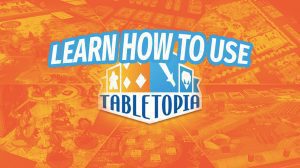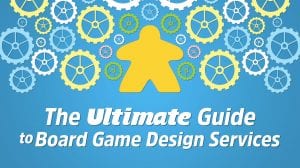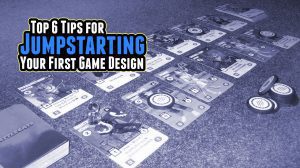The lower level of the Indianapolis bar has a ceiling about 2 inches lower than most places, instilling a sense of claustrophobia that adds to my nervousness. Men and women who look as anxious as I feel fill the room. With the speed dating event starting in 10 minutes, I find an empty seat and quietly review my lines. Even after practicing my opening for two hours in my car, I still feel unprepared. I feel my phone vibrate in my pocket. It’s my wife texting me, wishing me good luck on my speed dating event.
Unlike most speed dating events which match up potential mates, this speed dating event matches up game designers and publishers. The speed dating event at Gen Con has been connecting established publishers with indie game designers for almost a decade. Many other conventions, such as Origins, have also held their own speed dating events for several years. While most boardgamers have never heard of designer/publisher speed dating, also called speed pitching, it’s ultimately boardgamers who reap the benefits.
“Speed pitching introduces variety to publishers’ lineups, keeping them from getting too repetitive,” claims Matt Holden, owner of Indie Game Alliance, “It also helps designers who have made games targeting a particular IP link up with publishers that have access to licensing for it.”
Matt Holden is also the organizer of 2022 Gen Con Designer/Publisher Speed Dating. It takes several weeks to plan this event, but Matt enjoys helping out indie designers get their games published as much as he loves to see publishers expand their line of games.
The Event Begins
I set up my game on one of the designated tables. With two designers per table, I have a little less room than I’d like, but I decide I can still make it work. There are about 30 people in this lower level now in a space that was meant to only hold about 25 comfortably. The din of voices reflects the anticipation of the room as the event is about to start. I realize I’ll need to speak just below a yell If I want anyone to hear my pitch. The first publisher gives me a bright smile and puts his hand out. I shake his hand, trying to match the friendliness of his smile.
“Hi, my name is Bryan,” he says while he hands me his business card. My smile turns up slightly more when I see the Asmodee website on the bottom of Bryan’s card.

The Speed Pitch Format
The proceedings of game designer/publisher speed dating are straightforward, at least in theory. There are 10 to 20 designers who pitch their games to 10 to 20 publishers. Each designer has 5 minutes to tell the publisher about their game and answer questions. Then the publishers move to the next designer. Speed pitching events can last up to 2 to 3 hours with few breaks, if any, between pitches for either designer or publisher.
For the designer, the real trick is to summarize in three or four minutes something they’ve poured their heart and soul into for the past few months, sometimes years. There are four basic parts to a good speed pitch: vitals, hook, component list, and turn demo.
Vitals – The Vitals refer to the title, theme, number of players, target audience, gameplay time, and primary mechanic. This provides the foundation for publishers to understand the remaining aspects of the pitch.
Hook – The Hook is what makes the game fun and unique. Describing what makes a game fun and unique without using the words “fun and unique” is probably the most difficult aspect of the pitch. It’s also the most vital. A designer needs to understand what makes their game stand out and provide those details succinctly to a potential publisher.
Component List – This is a summary of all the game components. This gives the publisher a sense of what the game will cost to produce. New designers should be aware of high-cost components like polyhedral dice. These are not necessarily deal breakers, but a designer will need to explain why their game needs such components.
Turn Demo – The Turn Demo is an example of a typical turn in the game. Ideally, a designer wants to highlight the best aspects of the game. This can be difficult for medium and heavy games, which require a lot of context to understand the choices. Most designers try to set up their game so the publisher goes through a “scripted” turn. Of course, then the trick is to be able to reset the turn for the next publisher in the brief moments between pitches.
The remaining minute or two is the publisher’s time to ask questions. A designer should be prepared to answer any number of questions from publishers like the following:
- How many unique pieces of art are needed for your game?
- What size of a box do you need to fit everything?
- How much playtesting have you done? Have you done any blind playtesting?
- Have you playtested this with your target audience?
- Do you have the rules written out?
The pitch process is then repeated 10 or 20 times, depending on the number of publishers.
Most pitches follow the above steps like clockwork. But with so many people with all different perspectives and personalities in one room, sometimes a designer will have a curve ball thrown at them. In 2016, during a speed pitch event (that wasn’t at Gen Con) a 3-member publisher team approached my table. One of the members appeared to have had a little too much to drink earlier in the evening. About 20 seconds into my pitch, he starts to yell, “GOOD! NOW LET’S ROLL SOME DICE! I WANNA ROLL SOME DICE!” He continued to yell this over the next five minutes. His more sober team members asked me to just ignore him and continue. It was quite challenging to complete the pitch with such a distraction. Luckily, everyone at the 2022 Gen Con Speed Pitch event is on their best behavior.
The Sell Sheet
After about eight or so publishers, I get a little break. There are a few more designers than publishers at the speed pitch. The designer next to me has a short break too, so I get a chance to talk with him as we both soothe our throats with a cold drink. The two of us give out a short laugh to each other as we both recognize the expressions of encroaching fatigue, but building excitement on each other’s faces. His name is Darren Reckner, and he’s one of the designers in our local monthly playtest group, The Cincinnati Tabletop Game Designers group. Technically speaking, Darren is my competition. Both of us are fighting to get noticed by the publishers in the room. But the design community doesn’t function in that competitive sense. We celebrate each other’s successes. Traditionally, veteran game designers share their knowledge with others, ensuring the next generation of game designers also understands the many paths to success.

Darren has an awesome robot battling game called Aimbots, and I truly hope it gets picked up by a publisher. The 2022 Gen Con Speed Dating event is his first speed dating experience. He learns quickly and has some great tips for any designer going to their first speed dating event.
“You can’t guarantee that the perfect publisher for you will be at the event. You can guarantee that you are the most prepared person at the event, though. Rehearse your elevator pitch until you have it down cold. Get your sell sheets reviewed multiple times and take the feedback seriously,” Darren advises.
The sell sheet is a critical part of speed pitching and an art unto itself. You can think of it as a text version of verbal pitch. The sell sheet must contain vitals, hook, and component list contained in the verbal pitch. However, the sell sheet also contains some important differences like the game logo, game photo, and contact information.
This is a lot of information to fit onto one sheet of paper. One of the biggest challenges is arranging all these elements in a way that is not only visually appealing but intuitive. Whatever information a publisher is looking for, the answer must be quickly found on the sell sheet. Unfortunately, there is no standard format for a sell sheet. As Darren mentioned, creating a good sell sheet means getting feedback and improving the design with each version.
At this Gen Con speed pitching event, every designer is expected to provide each publisher with a sell sheet of their game. If a publisher is interested in a particular game, they will use the information on the sell sheet to contact the designer.
The Origins of the Gen Con Speed Pitch Event
“NEXT!” calls out Matt Holden. Designers wrap up the answers to the final questions from the publishers. Hands are shaken and the publishers begin to make their way to their next tables. The designers take a couple of deep breaths as they reset their tables. They reapply their friendliest smiles and greet the next publisher.
“Good evening,” I say to the next publisher as I hand them a sell sheet, “This is Meeple Kombatz, a meeple rolling speed game…”
Out of the corner of my eye, I see Matt Holden reset his watch.
Matt inherited the speed pitching event from James Mathe of Minion Games, who organized the first Gen Con speed pitching event in 2013. James Mathe is a legendary figure in indie game designer circles. He owned a blog that served as a comprehensive guide to game design from concept to publication. He also started one of the biggest game design-focused Facebook groups. Sadly, James Mathe passed away in 2019. Fortunately, others have continued his legacy by taking over the Facebook group and Gen Con Speed Pitching event.
“I’d love to say we do it as well as James did, and hopefully we do,” says Matt Holden. “But we will keep doing it as long as people keep coming, because we love helping designers get their games out into the world as much as we love publishers getting to expand their catalogs with fantastic new games that are perfect fits for their existing lines.”
The real challenge for these events is publishers are often looking for something specific to complement their game line. If a publisher is looking for a mid-weight Euro game, they will pass on the light family game no matter how exciting and well-designed it is. I’ve never taken any kind of scientific poll, but I’d say only about 5% of designers who do a speed pitching event end up signing with a publisher. Despite the challenges, I still highly recommend new designers participate in speed pitching events. It’s a great way to understand what publishers are looking for, not just in a game but in a pitch. Succinctly conveying what makes a game fun and unique is a valuable skill for a designer. Speed pitching is a great way to practice this skill. Speed pitching events are also a great way to network with other designers. I’ve made many great friends who have helped me in immeasurable ways.
The Wrap Up
“And that’s time!” Matt Holden yells out as he officially ends the speed pitching event. He thanks all the designers and publishers for participating. I shake hands with the final publisher and try to quickly clean up my table. The next two-hour session of speed pitching starts in 10 minutes with a new group of excited indie designers. The early arrivers begin to scout out the best locations.
Sadly, as the 2022 Gen Con Speed Dating event draws to a close, I find myself among the 95% who didn’t end up signing with a publisher. After two hours yelling my pitch and answering a firehose of questions, I’m utterly exhausted. However, I still leave the Indianapolis bar with a smile on my face. I had a great time being in a room full of creativity and energy. While many publishers said Meeple Kombatz didn’t fit their line, they also told me it is a well-designed and complete game with an original concept. Meeple Kombatz’s biggest challenge is it’s a speed game and only a handful of publishers are looking for that type of game. The good news is several publishers gave me leads on other publishers who might be interested in a speed game. It was a tiring but encouraging night for me.
My search for a publisher continues.











great description Gary. As a budding designer living in Australia I would love to have access to these kind of events and face-to-face opportunites to pitch to publishers. It is an added layer of complexity for those of us away from the hubbub of this kind of event.